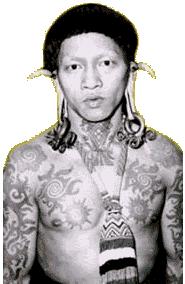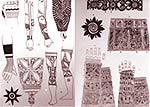On this day, a Penan wearing a pair of heavy ear-rings with body art "tattoo" is hrad to see.
 这门纹身艺术在肯雅、加央、依班几个砂拉越原
住民族群相当盛行。
这门纹身艺术在肯雅、加央、依班几个砂拉越原
住民族群相当盛行。
This artistic feature is widely practiced by the indigenous people of Sarawak especially by the Kayan, Kenyah and Iban groups.
身上不同部位的刺花都遵守祖宗的规矩。比如说 肩膀上、胸膛、手腕外刺圆形图案;大点的狗、 蝎子、龙形图案刺在大腿两边。而依班男人喉结 上的刺花有其特定的图案。
Different tattoo designs are produced and certain types are
considered appropriate for certain parts of the body. For
instance, the circular design is for the shoulder, chest or
 the outer side of the wrist while a more
elaborate and often larger design such as
a dog, scorpion or dragon, is reserved for
the inner and outer surface of the thigh.
Among the Iban, one distinctive design is
meant for the man's throat.
the outer side of the wrist while a more
elaborate and often larger design such as
a dog, scorpion or dragon, is reserved for
the inner and outer surface of the thigh.
Among the Iban, one distinctive design is
meant for the man's throat.

图片所示:土法纹身。
原住民纹身的意图多不可考,有多种说法。古早只有战
士手上刺青或者曾馘首。加央男女皆刺花。肯雅、加拉必女人也纹身。肯
雅加央的女贵族才在手臂、手指至肘部、腿部至大腿上刺花以示其地位并
身份。
 The reason for tattoing is many and obscure. In
the past, when a man's hand was tattooed, it meant
particularly brave in war or that he had taken some
heads.
The reason for tattoing is many and obscure. In
the past, when a man's hand was tattooed, it meant
particularly brave in war or that he had taken some
heads.
Among the Kayan, both men and women are tattoed. The Kenyah and Kelabit women are also tattoed.
Traditionally the Kenyah and Kayan aristocrat women had elaborate tattoo design on their arms from the fingers to the elbow and on their legs from below the knee to the upper thigh to symbolise their status.
Men and women also adorn their bodies with armlets made of brass and shell and earrings made of brass and lead.